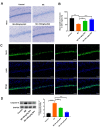Baicalein Alleviates Lithium-Pilocarpine-Induced Status Epilepticus by Regulating DNMT1/GABRD Pathway in Rats
- PMID: 40569104
- PMCID: PMC12203850
- DOI: 10.1080/15476278.2025.2519607
Baicalein Alleviates Lithium-Pilocarpine-Induced Status Epilepticus by Regulating DNMT1/GABRD Pathway in Rats
Abstract
Background: Epilepsy is a common disease of the nervous system. Recent advances in epigenetics have revealed DNA methylation as a key mechanism in epilepsy pathogenesis, particularly through dysregulation of GABAergic signaling. Baicalein has been shown to have anticonvulsant and neuroprotective effects. However, its epigenetic regulatory effects on GABA receptor function remain unexplored.
Methods: The status epilepticus (SE) model was induced by lithium chloride-pilocarpine (LiCl-PILO) in Sprague-Dawley (SD) rats. The rats were divided into control group, epileptic SE group and baicalein intervention group. Morris water maze (MWM) test, Nissl staining, immunofluorescence and enzyme-linked immunosorbent assay (ELISA) were used to detect cognitive functions and neuronal damage. Online sites, chromatin immunoprecipitation (ChIP) and western blotting were used to identify DNA methyltransferase 1 (DNMT1)-mediated methylation of gamma-aminobutyric acid type A receptor subunit delta (GABRD) promoter region.
Results: Baicalein treatment significantly prolonged the latency of SE onset and seizure onset, and improved the development of epilepsy. Meanwhile, baicalein improved the cognitive impairment in rats induced by LiCl-PILO. After treatment with baicalein, a sustained elevation in the number of neurons and NeuN levels was observed, along with a decrease in the contents of tumor necrosis factor -alpha (TNF-α), interleukin-1β (IL-1β), and ionized calcium-binding adapter molecule 1 (Iba-1) in the hippocampus. Mechanistically, baicalein interacted with DNMT1 to suppress GABRD promoter region methylation, thus increasing GABRD protein level in the hippocampus of rats induced by LiCl-PILO.
Conclusion: This study identifies DNMT1/GABRD axis as a novel epigenetic target for epilepsy intervention. Baicalein's ability to enhance tonic inhibition through demethylation of GABRD provides a groundbreaking strategy for drug-resistant epilepsy.
Keywords: Baicalein; DNMT1; GABRD; epilepsy; neuro.
Conflict of interest statement
No potential conflict of interest was reported by the author(s).
Figures






Similar articles
-
Vagus Nerve Stimulation Inhibits DNA and RNA Methylation in a Rat Model of Pilocarpine-Induced Temporal Lobe Epilepsy.CNS Neurosci Ther. 2025 Jun;31(6):e70484. doi: 10.1111/cns.70484. CNS Neurosci Ther. 2025. PMID: 40534269 Free PMC article.
-
GrpEL1 overexpression mitigates hippocampal neuron damage via mitochondrial unfolded protein response after experimental status epilepticus.Neurobiol Dis. 2025 Mar;206:106838. doi: 10.1016/j.nbd.2025.106838. Epub 2025 Feb 10. Neurobiol Dis. 2025. PMID: 39938576
-
Tropisetron, an Antiemetic Drug, Exerts an Anti-Epileptic Effect Through the Activation of α7nAChRs in a Rat Model of Temporal Lobe Epilepsy.CNS Neurosci Ther. 2024 Oct;30(10):e70086. doi: 10.1111/cns.70086. CNS Neurosci Ther. 2024. PMID: 39445711 Free PMC article.
-
Drug management for acute tonic-clonic convulsions including convulsive status epilepticus in children.Cochrane Database Syst Rev. 2018 Jan 10;1(1):CD001905. doi: 10.1002/14651858.CD001905.pub3. Cochrane Database Syst Rev. 2018. PMID: 29320603 Free PMC article.
-
Systematic review and meta-analysis of the efficacy of different exercise programs in pilocarpine induced status epilepticus models.Epilepsy Behav. 2017 Aug;73:256-267. doi: 10.1016/j.yebeh.2017.06.007. Epub 2017 Jun 27. Epilepsy Behav. 2017. PMID: 28666249
References
-
- González HG, Contreras-García IJ, Sánchez-Huerta K, Queiroz CMT, Gallardo Gudiño LR, Mendoza-Torreblanca JG, Zamudio SR. Levetiracetam reduced the basal excitability of the dentate gyrus without restoring impaired synaptic plasticity in rats with temporal lobe epilepsy. Brain Sci. 2020;10(9):634. doi: 10.3390/brainsci10090634. - DOI - PMC - PubMed
MeSH terms
Substances
LinkOut - more resources
Full Text Sources
